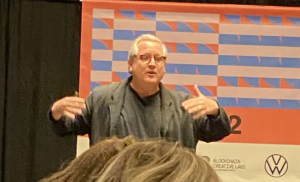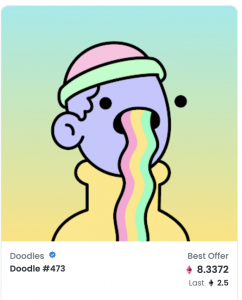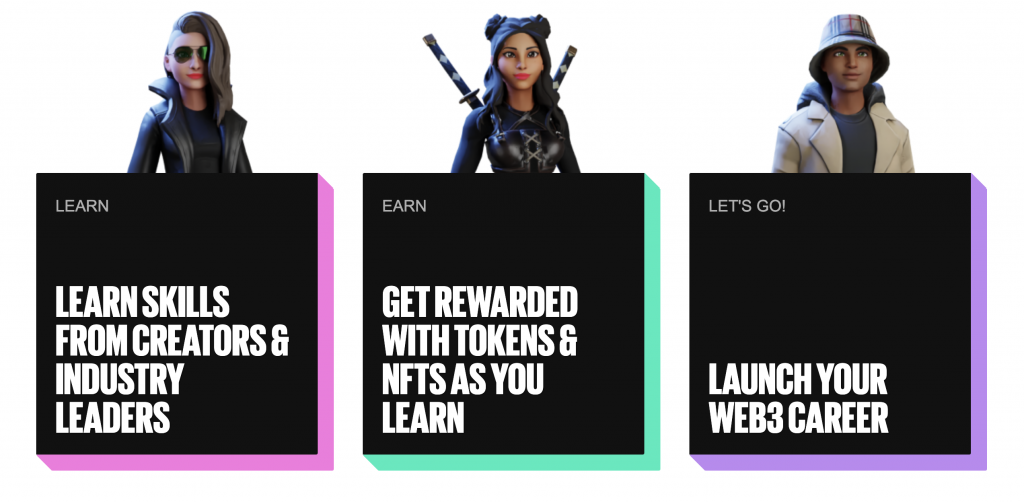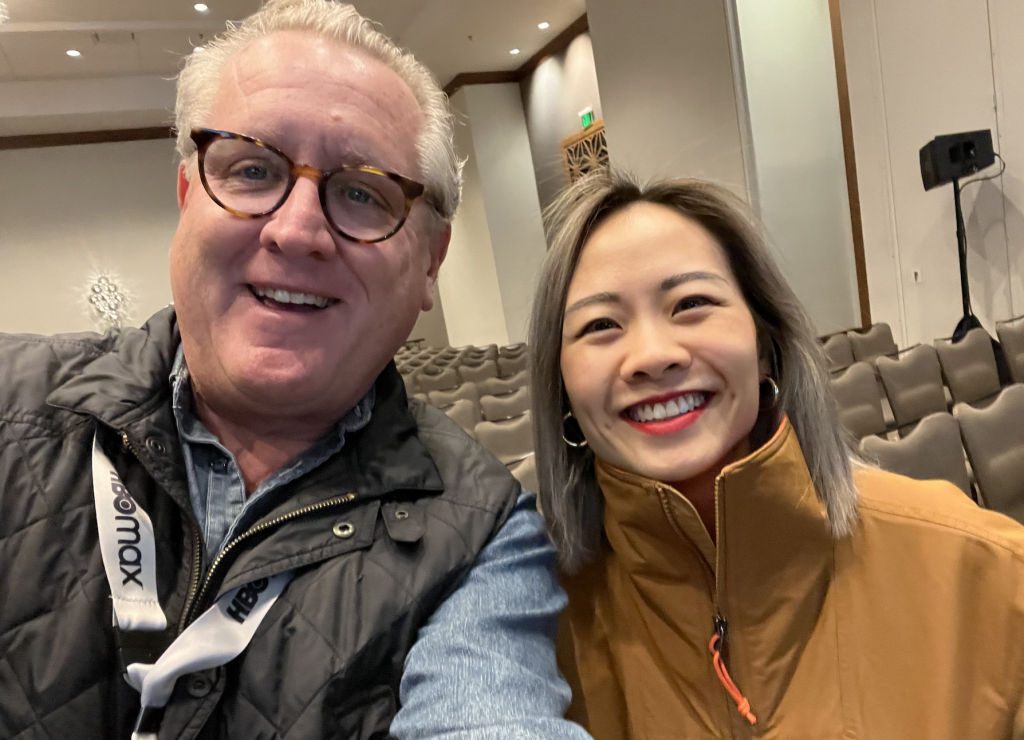
Today’s post is much different from my normal offering. I’m writing this from SXSW, an annual conference that is the epicenter of new ideas.
I thought it was more important to quickly share some rough notes rather than try to spend extra time on editing. SXSW is so massive it’s impossible to take in even a fraction of the content but here we go with some of the highlights of my annual visit:
Relentlessly Relevant

There were no good pictures of me at this event. This one contains a mound of hair in the foreground. But is really nice hair.
I gave one of the opening keynote talks of the event. My fourth time speaking at this event. Not the best slot since people were still arriving, but I was grateful for the opportunity and I had a full house. I debuted a new speech called “How to be Relentlessly Relevant in a Chaotic World.” The main ideas:
- Due to the world changing in such rapid and unexpected ways, we need new strategies to remain relevant. After all, isn’t every brand journey simply about relentless relevance?
- Instead of re-invention, which can take a lot of time, I talked about a strategy to re-apply existing strengths to waves of emerging opportunities.
- I covered three ways to find emerging seams and 10 relevant new waves crashing through the world right now.
If you’d like me to give this speech to your company or event, you can learn more and connect with me here.
Founder lessons
Entertaining talk from Patreon founder Jack Conte, who founded Patreon in his college dorm room. His talk centered on exploding entrepreneurial myths.
- Fascinating ideas about how through Web3, more and more artists have the ability to be brands and companies. So many new opportunities to monetize. Encouraged us to think more like businesses than artists.
- Almost every “rule” of starting a business is wrong. These are perpetuated by people selling rules.
- Number one life skill: Humility. Be ready to give up something you love if customers don’t want it.
Weird and wonderful branding
This lived up to its session title. So weird. So wonderful.
Company called WeTransfer transfers large files. Decided to partner with MeowWolf to showcase their creators while files transferred and they”ve become a bit of a creative agency. To set the tone for this session, check out this video created for a travel service.
If you can’t see the video, watch on YouTube.
Key cultural tone of creativity right now: Unexpected, subversive, polarizing.
Disrupt the feed and open conversations. Appeal to curiosity. Content is weird and getting weirder during the pandemic. The opposite of creativity today is represented by emails celebrating International Women’s Day or Pride Week (agree!).
The best creativity is “accessible unknown.” If it’s too accessible it’s boring. If it’s too unknown it’s confusing.
Radical creativity starts with something familiar and takes it in a place that is non-linear. What if it was a different time, place, person?
How do you measure creative success? >> What do people remember? What is still relevant three weeks from now? Not sure I agree with that if it doesn’t sell what you’re supposed to sell. At that point, it’s not marketing, it’s art. Both are OK but let’s not confuse the two : )
Building a next-generation brand
Doodles is a joyful collection of 10,000 NFTs co-founded by digital artist Burnt Toast and Web3 pioneers Evan Keast and Jordan Castro.
They have turned Doodles’ pastel and simple characters into an NFT community sensation.
Created more than $300 million in revenue. Most of this revenue comes from re-sales of the NFT art.
Created a “Doodle Bank” fund for the NFT owners — $3 million for community projects. Community votes on how to use it. Creative projects, travel to events, Ukraine relief. If a proposal has 1,500 votes the project is considered. The community voted to spend money on an activation at SXSW, a first.
Some Doodle community members collaborated to create a Doodle coffee brand. Some created an animated Doodles space launch which involved original art, music, animation.

“NFT culture is toxic and weird. We are trying to create a bridge from traditional entertainment to Web3. It gives people an opportunity to own a piece of the story.” – Evan Keast
NFTs are going mainstream but just early days. Collections are like an album drop. The art can move into movies, TV, merchandise, games. They want the community to have a stake in that.
Challenge: Balance demand without diluting the scarcity of the art. Owners can commercialize the art they own by licensing. Also, how do they keep media companies from buying up Doodles and commercializing in a mainstream channel?
Just an FYI, this Doodle is selling for about $25,000:

Three years from now this statement will either make me look like a genius or a fool: “A lot of this reminds me of Beanie Babies.”
Gen Z, Metaverse and the Future of Work
Session with Esther O’Callaghan (founder of Hundo), Jay Richards (founder Imagen Insights).
Hundo is building a metaverse university and career center. Hundo is slang for 100%.

Creating new bridges for disadvantaged children and tech careers. Many entry-level jobs are disappearing due to AI and automation.
“Away from the noise like the rabbits and bored apes, if you look at the capabilities and values of Web3 and the metaverse, there are some very interesting ways to help young people learn in new ways and transform their futures. Let people own their data and leverage their data, for a start. It’s our generation’s responsibility to help pave the way with this technology and then get out of the way.” – O’Callaghan
Imagen is a career coaching site for Gen Z and provides market insights to major brands. They pay Gen Z for opinions and market insights.
Will your job be based in the Metaverse — 20 percent said yes.
Gen Z sees the Metaverse as a corporate entity right now (Meta) and are nervous and skeptical. But 53 percent are willing to buy goods off the metaverse.
Gen Z is very nervous about AI taking their jobs. Do not want machines replacing people.
Gen Z is an activist generation. They will cancel you in a heartbeat if you are counter to their values.
Does the metaverse break down barriers or erect new ones between generations, between technical knowledge, between people who can afford the VR technology? A new layer of privilege?
Gen Z can find safe communities for every niche interest. They have safe spaces for any interest that might be seen as nerdy by society. “You can go down deep dark holes of nerdiness.”
Future of space exploration
There was a major space theme this year and I’m a NASA geek so could not miss attending at least one session! It was a great one featuring Ariel Exblaw, director of the MIT Space Exploration Initiative.
We are on the cusp of commercializing space in a massive way. Just as flight started with government and military applications and moved to commercial flights, that’s where we are with space. Space manufacturing labs, moon habitats, vacation trips are in the works.
A huge space-related eco-system is emerging to support this future.
MIT is sending a research mission to the moon to find water, possible habitat.
They are creating thumb-size “swarm robots” that will detect environmental issues in space and make repairs. Concurrently cool and terrifying.
Precedents will soon be set about property rights on the moon.
Some keys to successful space living:
- Community modules that make money instead of suck up money
- Robotic assembly and maintenance which take hazards away from humans. She had a video of self-assembling space buildings. Fascinating.
- Answers to long-term psychological stress
Humans will return to the moon in the 20s. Manned mission to Mars in the 30s or sooner. Several new missions are planned to find life on Mars and Europa.
MIT is building a Starfleet Academy (!) called Aurelia Institute to build starships of the future. This was announced for the first time at SXSW. I was their fourth follower on Twitter!
“Anthropocosomos” — Terrible name. Cool idea — Dawn of humanity in space. How do we become responsible stewards of space? We are already littering space with a cloud of dangerous debris. “A serious problem.” We need to start cleaning space! Profound legal and ethical issues.
As I listened to this talk I could not help but think about how evil persists everywhere and what evil looks like when we start to live in space.
The new creator economy

Maven co-founder Wes Kao gave a blockbuster speech on creator trends. (I am a Maven creator).
Three big ideas:
1. Shift from content to community
Knowledge influencers aren’t macro famous, but “famous to the family” (I’m in that category!) and are loved for their expertise. This creates new career opportunities because brands are seeking partnerships with these leaders and fans want their insights.
One trend is bi-directional education. Teaching used to be about passive content consumption. But if you have a community, you can engage in a bi-directional approach means the instructor leads, but students learn from each other.
If you have a community, it’s easier to create courses for these like-minded people and charge a lot more money because you’re known.
2. Shift from hamster wheel to productized assets
Creators usually can spend as much as 80 hours a week on content. Some may spend 40 hours on a 10-minute video. She gave an example of a 30-second video that took five hours to produce. Great content is NOT EASY!
Being a creator is not freedom. It’s hard to sustain and many creators are burning out and dreading the process. You’re on a hamster wheel.
One strategy is to consider productized assets — you can sell the same content multiple times:
- eBooks/books
- Templates
- Guides
- Video courses
- Email course
- Cohort-based courses
3. Shift from hobby to career
There are 50 million creators and they make an average of $17,000 per year. Problem is volume. You need a big audience or tons of subscribers to make a significant brand deal or to leverage subscriptions/Patreon.
For most creators, a better idea is to focus on a smaller core audience and meet unique needs they are willing to pay a lot for.
My view — I think this is a very positive and healthy view and I am a big Wes Kao fan. But ultimately a sustainable income needs scale, even by finding more students or creating more classes (kind of a hamster wheel?)
Biggest Tech trends

Amy Webb, CEO of Future Today Institute published 14 reports online for free.
She highlighted three foundational trend clusters:
1. Artificial intelligence
AI is permanently altering our perception of reality.
Image generation and image recognition are now pervasive and accurate.
We are very near AI general intelligence. Ai can make its own decisions, without humans in the loop. Indistinguishable from human intelligence. In fact, AI wrote this complete and accurate part of the research report in 3.9 seconds. She said this is a reason to “freak out.”
AI is moving forward through tons of data. And we’re providing the data through all these apps we use. AI can recognize you by your “heart print.” A laser can identify you through your heartbeat, through your clothes, 200 yards away. AI does not need your face to see you. You can even be recognized by your breathing pattern. Will we be under constant surveillance without some regulation? Will we wear heartbeat blockers?
We can design realistic synthetic digital humans indexed toward certain emotions. They can be especially warm, patient, and helpful. We can dial in emotions. They can respond to you, using these emotions, and answer you using all the data available in the world. The future of customer service. Also ethically problematic when you are dealing with non-real people and may not know it.
Should it be a law to disclose when you’re dealing with a non-human?
In three years, her institute shows an 80% probability of catastrophic impacts from AI-generated fake news and deep fakes.
2. Metaverse, Web3
“We’re all chasing the shiny.” However, digital real estate and NFTs are not the long-term play here.
It is the next version of the internet but it will be based on our data from an “unthinkable number of factors.”
Digital experiences will be more human, more real, it will even include smells. We will use our bodies to be present and communicate more effectively in the metaverse. Our digital presence and identity will follow securely us around.
We will have high-fidelity metaverse humans. We will create multiple versions of ourselves, acting in different ways in different spaces (we already do this on Web2, i.e. how we show up on Facebook versus LinkedIn. We may have to “port” ourselves into various meta worlds.
We’ll be able to buy virtual shoes we will wear in the metaverse and have the real pair delivered to us at the same time.
Digital art will only be a thing if there is scarcity. And there is not much scarcity. The market is already saturated with NFTs. This is likely not art that will earn value. NFTs are a distraction, she said.
However, the infrastructure that enables NFTs will lead to huge breakthroughs in basic business structure.
There are already bad things happening on the Metaverse — people acting like aggressive cops, people being sexually aggressive. Who is policing the metaverse? Based on what cultural traditions?
Targeted dream incubation (like the Inception movie). It’s possible to influence dreams through altered experiences and sleep tracking. No thank you.
Optimistic scenario: more inclusivity, accessibility, transparency
Catastrophic scenario: digital marketing is dead because there is no true customer data. Everybody is made up. There is a huge digital divide between those who participate and those who do not.
3. Synthetic biology
Tech and biology are becoming one. We can design organisms to do what we want. We can program biological systems. In 10 years, we will be talking about this like we are talking about AI today.
We can program chickens to grow bigger and use less food without hormones and chemicals. We can even create synthetic, cultured chicken. It is already being manufactured in Singapore. Genetically not distinguishable. Singapore, which has no farmland could be a major exporter of chicken.
Machines can now literally print out DNA sequences.
Microsoft is working on DNA hard drives. They can retrieve data from organic DNA. This will lead to miniaturized data storage. Roswell has created a molecular microchip. This is an ‘incredible revolution.’
We can create fertilized eggs from the DNA of one human. China created edited babies. Those babies will pass along their edits. We are now living with enhanced humans.
RIsks — easily reproducing viruses, having your DNA hacked. People can make viruses specific to a human.
Her summary: “Have you ever noticed that every disaster movie starts with the government ignoring scientists? That is the basis of every catastrophic scenario. Ignoring science and letting catastrophes happen.
The problem I see, and perhaps the seed of inevitable catastrophe, is that ultimately EVERY government has to listen to science. Just takes one lone wolf to create problems.
NFT opportunity and skepticism
There was a fierce debate all over SXSW about NFTs. Is it silly crypto crap or the future of business, games, social, and entertainment?
I went to a few sessions. It’s probably both.
Art aspect of NFTs is way over-hyped, but the underlying infrastructure is what is important.
Andy Yang of Forte explained that there is a vision of the future here. He was skeptical but is excited because:
- An incredible number of smart people are jumping into the space
- What we are seeing today might be silly, but it is a prototype of the future. It’s reinventing property rights and ownership.
- Revolution of economic organization — aggregating capital to go build something. Transformative.
- There is a backlash about Web2 companies like Facebook. Need a model built on trust.
- We are in a period or polarization. These Web3 micro-cultures give passionate people a safe place to belong.
- There is a GenZ energy behind it that is unstoppable. This explosion was fueled by the pandemic
There are so many scams and shallow people pimping NFTs that it is ruining the industry. Young people and gamers want authenticity and trust and they don’t know who to believe.
Another problem — there is such a gold rush in the space that people are putting out crap and people will be disillusioned. But eventually this will work out.
Very complicated economics. Money used to flow one way. Employer to employee or consumer to supplier. But now tokens are flowing in every way. We can’t begin to imagine the opportunities.
What was missing
I’ve attended SXSW each year since 2010 so I am aware of patterns and themes. Here are some things that were missing:
Craziness — You can always count on wacky promotions and gimmicks as entrepreneurs and founders vie for attention. The whole tone of SXSW was subdued.
People — The last live event in 2019 attracted about 200,000 people. Honestly, it was overwhelming. I have not seen the official numbers but I would guess there is about one-third that number this year. The large contingents from Asia, Australia, and Europe that flock to the festival was notably missing.
Protests — SXSW is a hub of free-thinking and peaceful protests. There wasn’t even a Ukranian flag anywhere. Weird.
Brand activations — SXSW is known for its breath-taking and creative brand activations. Companies take over every open space with immersive experiences, art, and music. Almost nothing this year. Very muted.
Blogger lounge — The coolest hang-out at SXSW was always the blogger lounge. Gone. Have no idea why.
Social media sessions — There are four overlapping conferences here: Education, Interactive, Film, and Music. Interactive was basically founded around the emerging digital media scene 15 years ago but that was almost completely absent this year! With the exception of a TikTok session or two, there was barely a mention of Facebook, Instagram, and the like. Also, topics like influence marketing and brand content that were huge a few years ago were out. In: Metaverse, Web3, space exploration, Gen Z, creator economy, post-pandemic branding, and SO MANY talks about NFTs (and all of them were packed).
Those are my notes. How did I do?
 Mark Schaefer is the executive director of Schaefer Marketing Solutions. He is the author of some of the world’s bestselling digital marketing books and is an acclaimed keynote speaker, college educator, and business consultant. The Marketing Companion podcast is among the top business podcasts in the world. Contact Mark to have him speak to your company event or conference soon.
Mark Schaefer is the executive director of Schaefer Marketing Solutions. He is the author of some of the world’s bestselling digital marketing books and is an acclaimed keynote speaker, college educator, and business consultant. The Marketing Companion podcast is among the top business podcasts in the world. Contact Mark to have him speak to your company event or conference soon.
Follow Mark on Twitter, LinkedIn, YouTube, and Instagram. Discover his $RISE create community.


